User Interface in Core
Overview
UI in Core includes all the 2D elements that can be used to build menus, notifications, dialogue boxes, and heads up displays (HUD's). Creating UI Elements is mostly a drag-and-drop process, where any UI element can be added to the scene with ease.
UI Elements
Control
A Control (UIControl) is a CoreObject which serves as a base class for other Controls. All UI classes include the properties within a Control such as the position and size properties.
More information can be found in the UIControl API
Container
All other UI elements must be a descendant of a Container (UIContainer) to be visible. It does not have a position or size. It is always the size of the entire screen. It has no properties or functions of its own, but inherits everything from CoreObject.
More information can be found in the UIContainer API
Container Types
Containers have a Content Type which allow creators to specify the way the UI works and optimize performance. By default, Containers will have the Dynamic type, but can be made more performant by changing their type to Static in instances where they do not need to move.
UI Type Definitions
- Static: Used for any UI that does not need to move.
- Dynamic: Used for any UI that will move.
- Texture: For extremely complex UI with many elements to be rendered as a single texture, like Minimap UI.
Texture Content Type
The Texture Content Type has greater cost than the other UI Container Content Types, but this cost is fixed. It is recommended to only use one Texture per project.
Panel
A Panel (UIPanel) can be used for containing and laying out other UI elements, such as images and text. It is optional and is best used for organization.
Panels also have an Opacity that will be applied to all elements inside of it.
More information can be found in the UIPanel API
Scroll Panel
A Scroll Panel (UIScrollPanel) is a Panel that has a scroll bar for overflowing elements.
More information can be found in the UIScrollPanel API
Image
An Image (UIImage) displays a given image (found in the Core Content window).
More information can be found in the UIImage API
Change the Image in the Editor
Like Materials on static mesh objects, there are two ways to change the image being displayed; either by dragging from the UI Textures category of Core Content or by selecting from the Properties window, and double-clicking the icon in the Image property.
Change the Image with Script
If you have an asset reference to an image (or its MUID), you can use the UIImage:SetImage() function.
Images can also be manually set to show a player's profile picture by using the UIImage:SetPlayerProfile() function.
Change the Color of an Image with Script
The color of an image can be changed dynamically by using the UIImage:SetColor() function.
Text
A Text (UIText) displays text.
More information can be found in the UIText API
Text Fonts
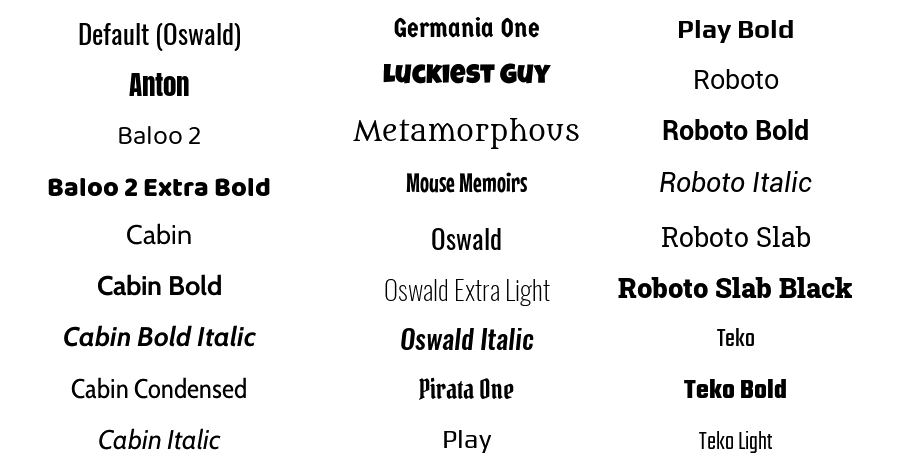
Change the Font
Like Materials on static mesh objects, there are two ways to change the font of text; either by dragging from the Fonts category of Core Content or by selecting from the Property Window, and double-clicking the icon in the Font property.
The font can also be changed with script by using the UIText:SetFont() function.
Change the Text with Script
The content of the text (what is actually being displayed) can be changed by setting a new value to the UIText.text property to a new string.
TextObject.text = "New Value"
Change the Color of Text with Script
The color of text can be changed dynamically by using the UIText:SetColor() function.
Get the Visual Size of a Text with Script
When the text is being rendered on the screen, you can get the amount of pixels that it takes up on the screen by using the UIText:ComputeApproximateSize() function.
Progress Bar
A Progress Bar (UIProgressBar) displays a dynamically filled rectangle that can be used for things such as health indicators, loading screen, and much more.
More information can be found in the UIProgressBar API
Change the Progress with Script
The progress is set by using a scale of 0 to 1 (meaning 50% would be 0.5). This can be set by changing the value of UIProgressBar.progress to a new number in that range.
ProgressBarObject.progress = 0.6 -- 60%
Button
A Button (UIButton) can be clicked and interacted with. This must be in a client context to function.
More information can be found in the UIButton API
Listening to Events
A button has several events that can be listened to that informs you if it was clicked, hovered, etc. You can listen to these by figuring out which one is needed (look at the API for reference) and connect it to a function.
An example using UIButton.clickedEvent
function OnButtonClicked(button)
print(button.name, "clicked")
end
ButtonObject.clickedEvent:Connect(OnButtonClicked)
Perk Purchase Button
A Perk Purchase Button (UIPerkPurchaseButton) is similar to a regular button but allows players to purchase perks within a game. It is designed to present a consistent purchasing experience for players across all games.
More information can be found in the UIPerkPurchaseButton API
Toggling UI With a Trigger
There may be situations you want to show UI when a player enters a certain area in the map. This can be done by utilizing Triggers.
In this example, the trigger will show a UI that informs the player that they are in a specific zone, the "Red Zone."
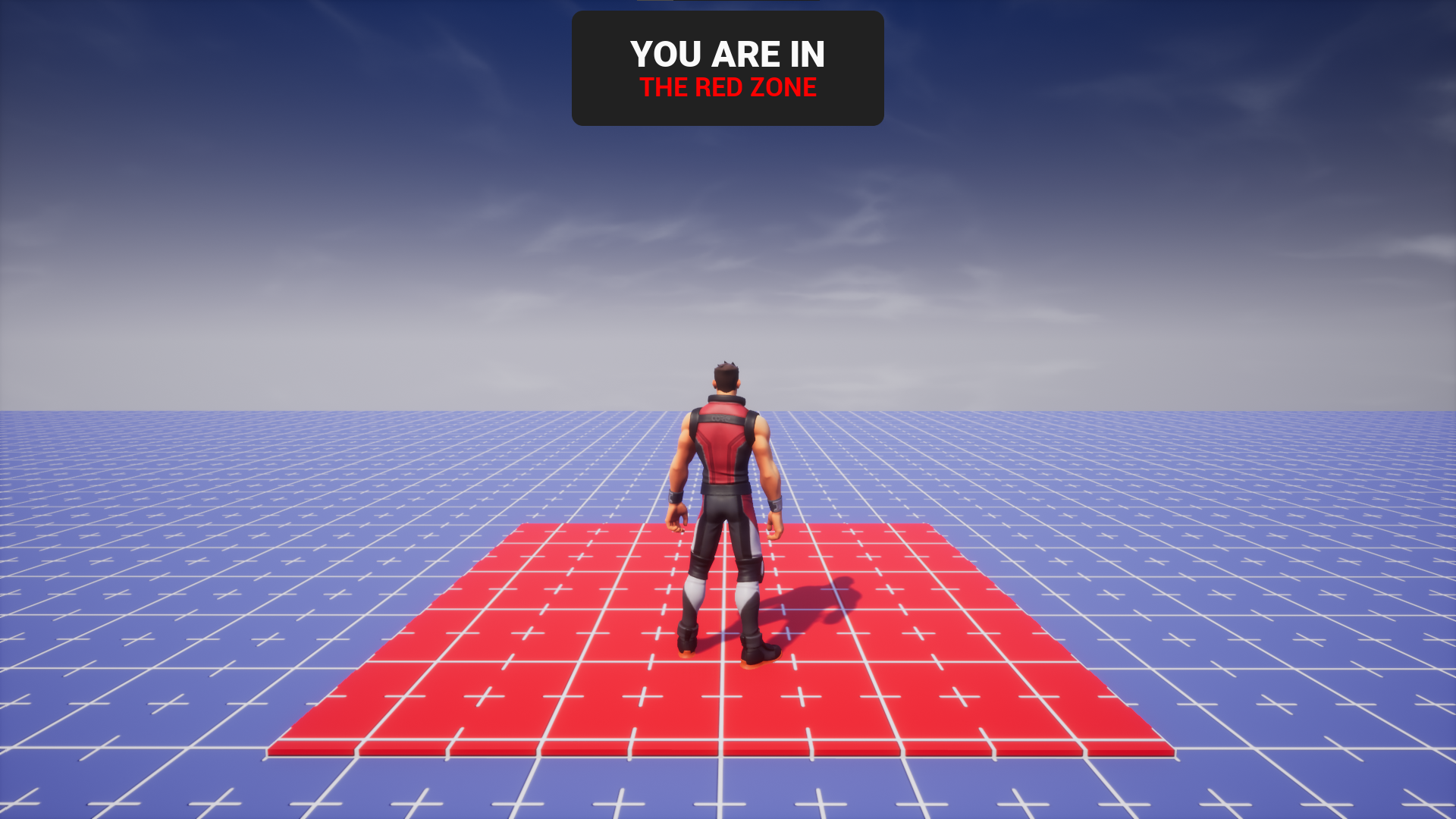
Create a Script
First, you need to create a script that will handle this implementation.
- Create a script inside the UI that will be toggled using the trigger. The name of the script can be anything; this tutorial will be using
ToggleOnTrigger.

Create Custom Properties for the UI and Trigger
Second, you need a reference to the UI and to the trigger so that you can implement the required trigger events that then toggle the UI.
- While having the script selected in the hierarchy, in the Properties window, add a CoreObjectReference Custom Property to the script and name it
Interface. - Drag-and-drop the UI from the Hierarchy into the Custom Property you just created.
- While having the script selected in the hierarchy, in the Properties window, add a CoreObjectReference Custom Property to the script and name it
Trigger. - Drag-and-drop the Trigger from the Hierarchy into the Custom Property you just created.

Create Variable References for the UI and Trigger
Now, it is time to begin coding. First, you need to create variables that refer the the UI and Trigger Custom Properties.
Add this to the top of your script:
local Interface = script:GetCustomProperty("Interface"):WaitForObject()
local Trigger = script:GetCustomProperty("Trigger"):WaitForObject()
Create Variable Reference to Local Player
The UI should only become visible if the Local Player (you, for instance) enters the trigger. Otherwise, if any Player enters or exits the trigger, the UI will have some very odd behaviour.
Under the Custom Property references, add this to the script:
local LocalPlayer = Game.GetLocalPlayer()
Connect Event When a Player Enters the Trigger
It is now time to show the UI when a Player enters the Trigger. This is used by utilizing the Trigger.beginOverlapEvent event.
At the bottom of the script, add this:
function OnBeginOverlap(trigger, player)
end
Trigger.beginOverlapEvent:Connect(OnBeginOverlap)
Toggle the UI On if the Local Player is Inside
Now you can check to see if the Player that entered the trigger is the ***Local Player**.
Inside the OnBeginOverlap function, add this check:
if not player:IsA("Player") or player ~= LocalPlayer then
return
end
The parameter is named player so it is easier to understand for the developer, but it is actually an Object, meaning it can be a Player or any CoreObject that enters it. Therefore, this will escape early if the object entering the Trigger is not a Player. This will also escape early if the Player entering the Trigger is not the Local Player.
Next, add this line of code to toggle the visibility of the UI to be inherit (visible only if all the objects it is inside is also visible):
Interface.visibility = Visibility.INHERIT
Connect Event When a Player Leaves the Trigger
It is now time to hide the UI when a Player exits the Trigger. This is used by utilizing the Trigger.endOverlapEvent event.
At the bottom of the script, add this:
function OnEndOverlap(trigger, player)
end
Trigger.endOverlapEvent:Connect(OnEndOverlap)
Toggle the UI Off if the Local Player is Inside
Now you can check to see if the Player that exited the trigger is the ***Local Player**.
Inside the OnEndOverlap function, add this check:
if not player:IsA("Player") or player ~= LocalPlayer then
return
end
Next, add this line of code to toggle the visibility of the UI to be off:
Interface.visibility = Visibility.FORCE_OFF
Hide the UI
Finally, you can disable the visibility of the UI so that when the Player spawns in, it is off by default.
- Click the UI in the Hierarchy.
- In the Properties window, change the Visibility to Force Off.
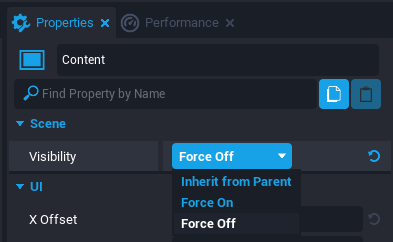
Final Code
local Interface = script:GetCustomProperty("Interface"):WaitForObject()
local Trigger = script:GetCustomProperty("Trigger"):WaitForObject()
local LocalPlayer = Game.GetLocalPlayer()
function OnBeginOverlap(trigger, player)
if not player:IsA("Player") or player ~= LocalPlayer then
return
end
Interface.visibility = Visibility.INHERIT
end
function OnEndOverlap(trigger, player)
if not player:IsA("Player") or player ~= LocalPlayer then
return
end
Interface.visibility = Visibility.FORCE_OFF
end
Trigger.beginOverlapEvent:Connect(OnBeginOverlap)
Trigger.endOverlapEvent:Connect(OnEndOverlap)
Toggling UI With a Binding
There may be situations you want to show UI when a player presses a certain button. This can be done by utilizing Bindings.
In this example, pressing T will show a UI that gives some quick information to the player about the game.
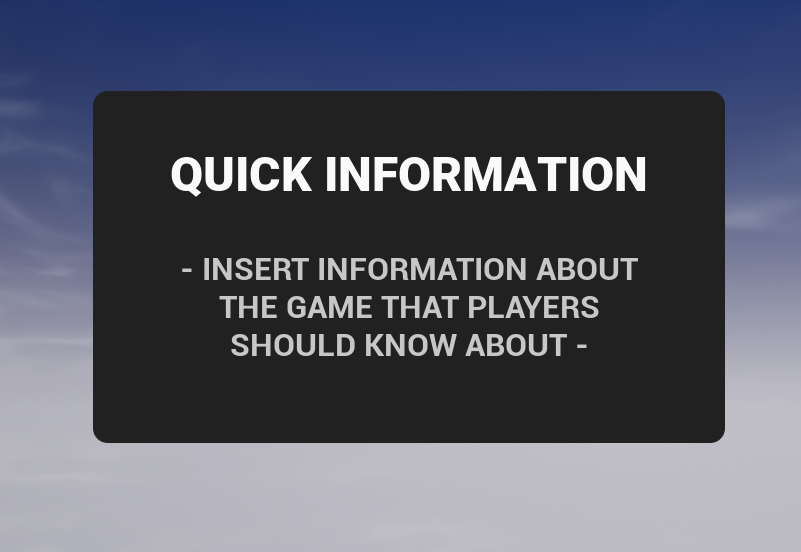
Create a Script
First, you need to create a script that will handle this implementation.
- Create a script inside the UI that will be toggled using the trigger. The name of the script can be anything; this tutorial will be using
ToggleOnBinding.

Create Custom Properties for the UI and Binding
Second, you need a reference to the UI and to the trigger so that you can implement the required trigger events that then toggle the UI.
- While having the script selected in the hierarchy, in the Properties window, add a CoreObjectReference Custom Property to the script and name it
Interface. - Drag-and-drop the UI from the Hierarchy into the Custom Property you just created.
- While having the script selected in the hierarchy, in the Properties window, add a String Custom Property to the script and name it
Binding. - Search the binding list for what binding you want to use. This example will be using T, which is
ability_extra_24.
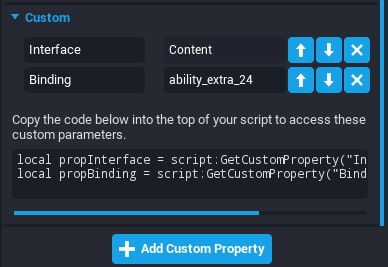
Create Variable References for the UI and Binding
Now, it is time to begin coding. First, you need to create variables that refer the the UI and Binding Custom Properties.
Add this to the top of your script:
local Interface = script:GetCustomProperty("Interface"):WaitForObject()
local BINDING = script:GetCustomProperty("Binding")
BINDING is in all caps to hint that it is a constant; a variable that the value is no altered.
Create Variable Reference to Local Player
The UI should only become visible if the Local Player presses the binding.
Under or between the Custom Property references, add this to the script:
local LocalPlayer = Game.GetLocalPlayer()
Connect Event When a Player Presses a Binding
It is now time to show the UI when a Player enters the Trigger. This is used by utilizing the Player.bindingPressedEvent event.
At the bottom of the script, add this:
function OnBindingPressed(player, binding)
end
LocalPlayer.bindingPressedEvent:Connect(OnBindingPressed)
Check the Binding
The bindingPressedEvent event fires when any binding is pressed so you need to check and see if it is the correct binding that you want it to be.
Do this by adding this to the top of the OnBindingPressed function:
if binding ~= BINDING then
return
end
This will escape early if the two bindings do not match.
Toggle the Visibility of the UI
Toggling the visibility of the UI can be done with a quick if/else statement.
Add this to the bottom of the function:
if Interface.visibility == Visibility.FORCE_OFF then
Interface.visibility = Visibility.INHERIT
else
Interface.visibility = Visibility.FORCE_OFF
end
Hide the UI
Finally, you can disable the visibility of the UI so that when the Player spawns in, it is off by default.
-
Click the UI in the Hierarchy.
-
In the Properties window, change the Visibility to Force Off.

Final Code
local Interface = script:GetCustomProperty("Interface"):WaitForObject()
local LocalPlayer = Game.GetLocalPlayer()
local BINDING = script:GetCustomProperty("Binding")
function OnBindingPressed(player, binding)
if binding ~= BINDING then
return
end
if Interface.visibility == Visibility.FORCE_OFF then
Interface.visibility = Visibility.INHERIT
else
Interface.visibility = Visibility.FORCE_OFF
end
end
LocalPlayer.bindingPressedEvent:Connect(OnBindingPressed)
Toggling UI With a Button
There may be situations you want to show UI when a player presses a button on the screen. This can be done by utilizing Buttons.
In this example, pressing the button will show a UI that gives some quick information to the player about the game.
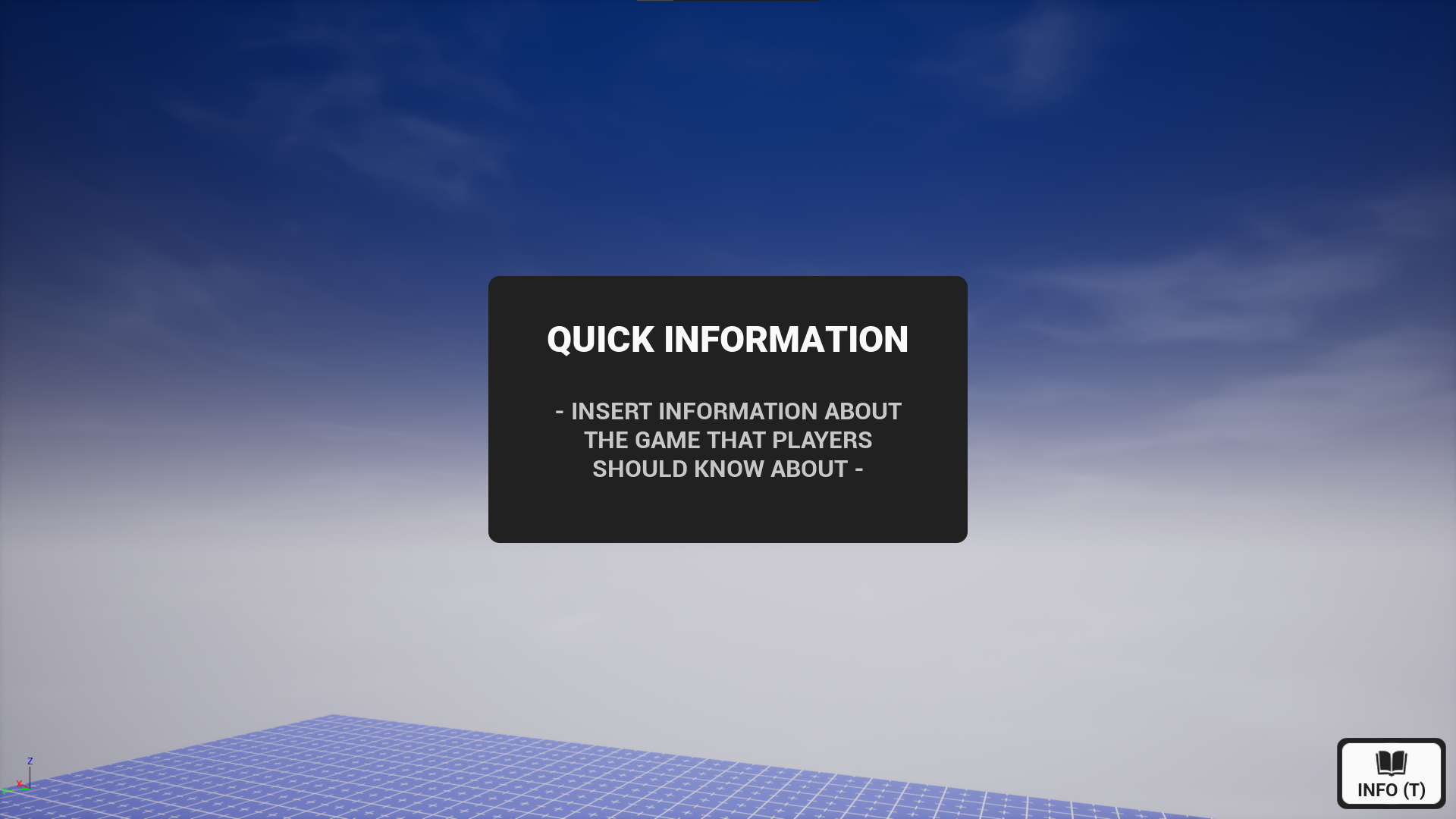
Create a Script
First, you need to create a script that will handle this implementation.
- Create a script inside the UI that will be toggled using the trigger. The name of the script can be anything; this tutorial will be using
ToggleOnButton.
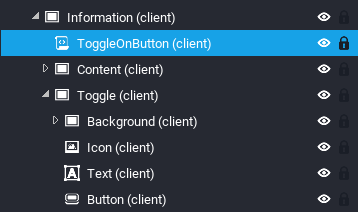
Create Custom Properties for the UI and Trigger
Second, you need a reference to the UI and to the trigger so that you can implement the required trigger events that then toggle the UI.
- While having the script selected in the hierarchy, in the Properties window, add a CoreObjectReference Custom Property to the script and name it
Interface. - Drag-and-drop the UI from the Hierarchy into the Custom Property you just created.
- While having the script selected in the hierarchy, in the Properties window, add a CoreObjectReference Custom Property to the script and name it
Button. - Drag-and-drop the Button from the Hierarchy into the Custom Property you just created.

Create Variable References for the UI and Button
Now, it is time to begin coding. First, you need to create variables that refer the the UI and Button Custom Properties.
Add this to the top of your script:
local Interface = script:GetCustomProperty("Interface"):WaitForObject()
local Button = script:GetCustomProperty("Button"):WaitForObject()
Connect Event When a Player Presses the Button
It is now time to show the UI when a Player presses the Button. This is used by utilizing the Button.clickedEvent event.
At the bottom of the script, add this:
function OnButtonClicked(trigger, player)
end
Button.clickedEvent:Connect(OnButtonClicked)
Toggle the Visibility of the UI
Toggling the visibility of the UI can be done with a quick if/else statement.
Add this to the function:
if Interface.visibility == Visibility.FORCE_OFF then
Interface.visibility = Visibility.INHERIT
else
Interface.visibility = Visibility.FORCE_OFF
end
Enable the Cursor
If you do not already do this somewhere else in your game, you can enable the cursor using the UI namespace.
Add this to the bottom of your script:
UI.SetCanCursorInteractWithUI(true)
UI.SetCursorVisible(true)
Hide the UI
Finally, you can disable the visibility of the UI so that when the Player spawns in, it is off by default.
- Click the UI in the Hierarchy.
- In the Properties window, change the Visibility to Force Off.
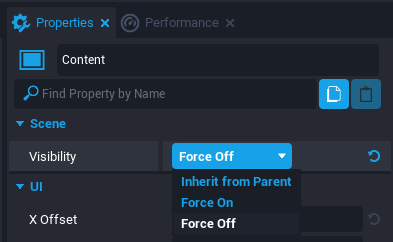
Final Code
local Interface = script:GetCustomProperty("Interface"):WaitForObject()
local Button = script:GetCustomProperty("Button"):WaitForObject()
function OnButtonClicked(trigger, player)
if Interface.visibility == Visibility.FORCE_OFF then
Interface.visibility = Visibility.INHERIT
else
Interface.visibility = Visibility.FORCE_OFF
end
end
Button.clickedEvent:Connect(OnButtonClicked)
UI.SetCanCursorInteractWithUI(true)
UI.SetCursorVisible(true)